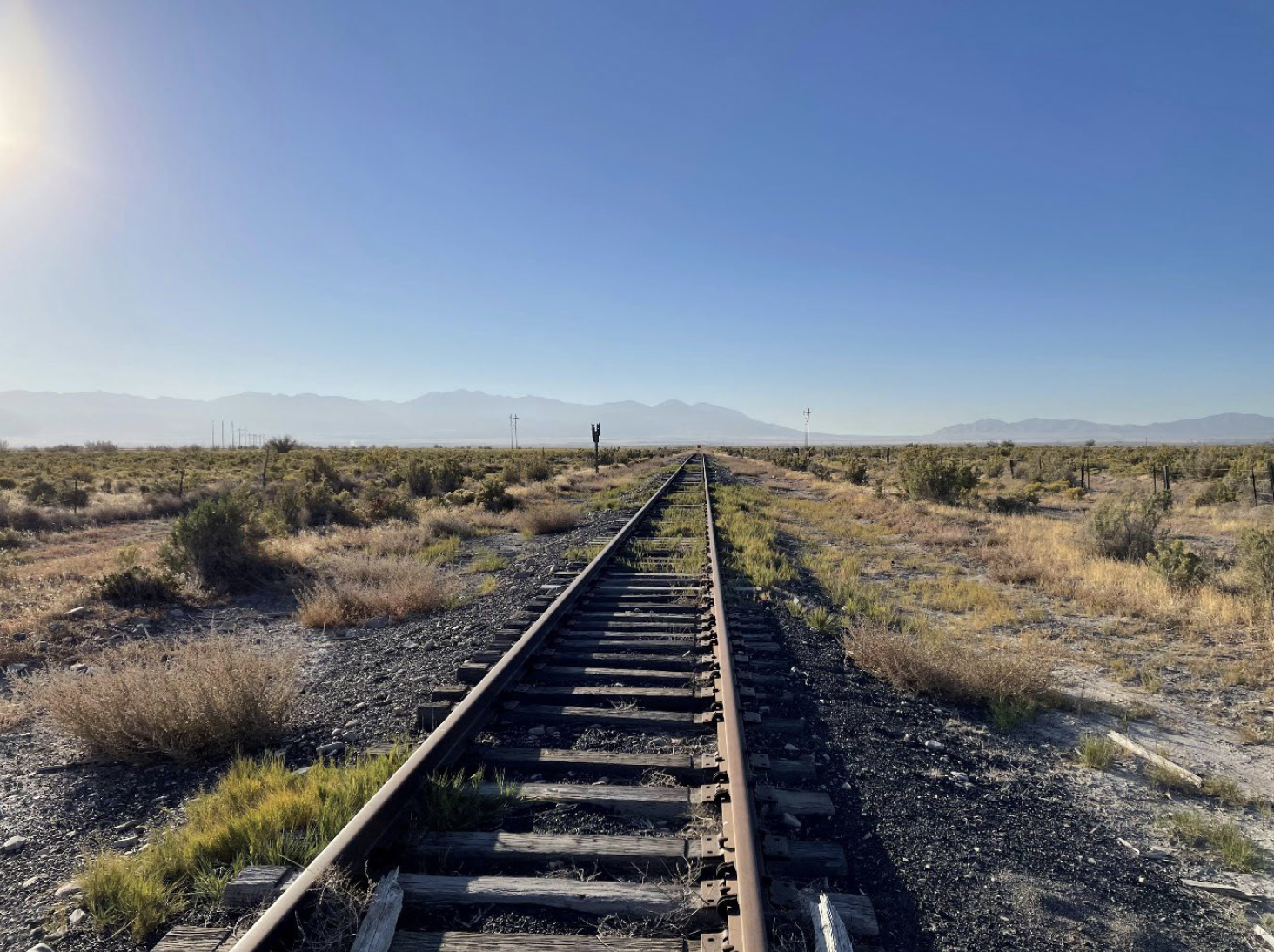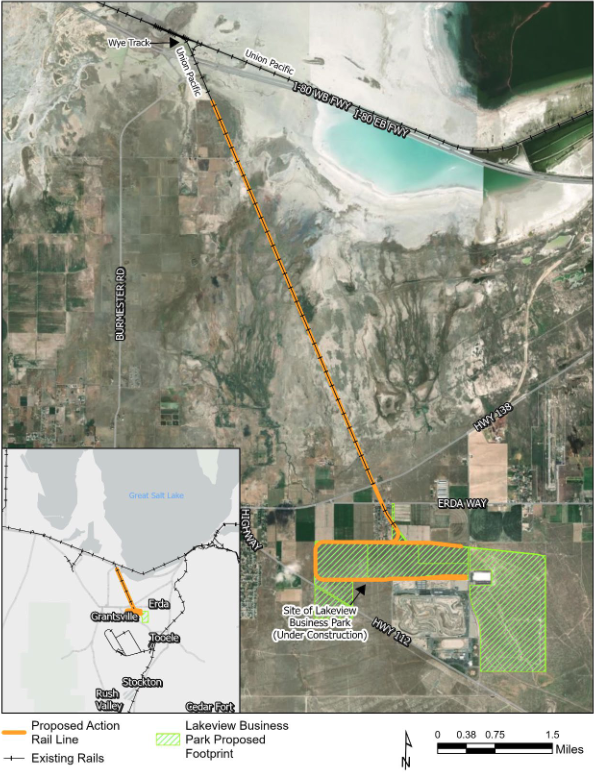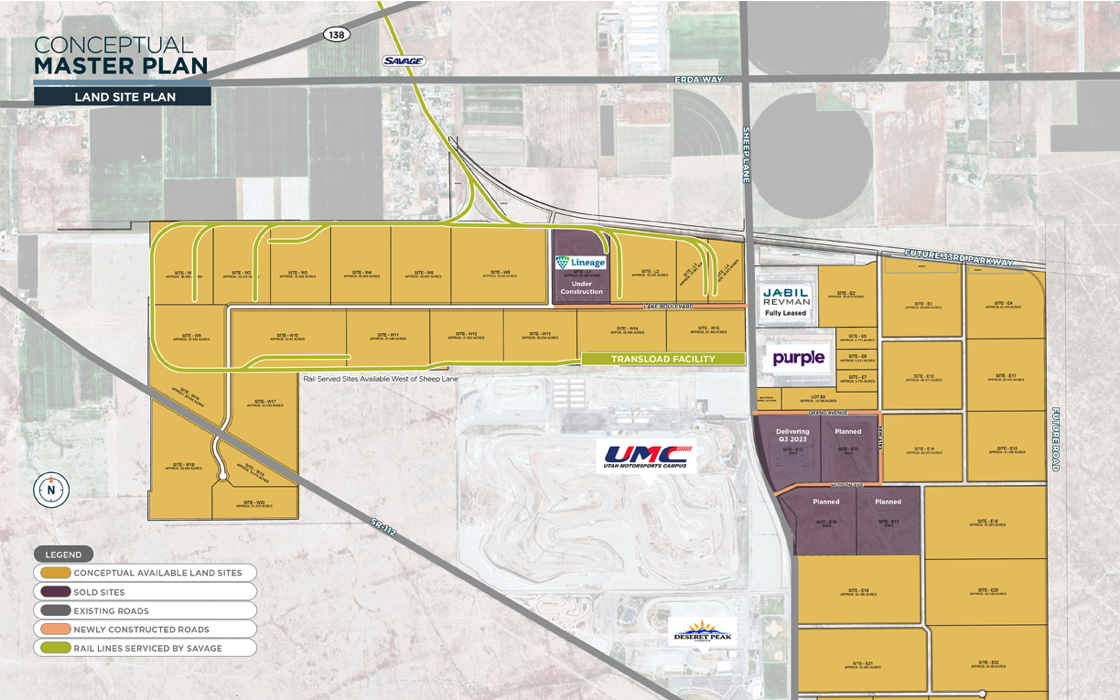
To see why it is so difficult to build anything these days, consider the sad case of the proposed Savage Tooele Railroad.
Savage wants to revive Union Pacific’s abandoned 6-mile Warner Branch in Tooele County, Utah, restore a quarter mile of ripped-up track, and build 5 miles of new track within the Lakeview Business Park and its planned 800 acres of rail-served property. The business park is under construction in Grantsville, which sits southwest of Salt Lake City.
Tooele is the fastest-growing county in Utah and lacks the rail lines necessary to meet future transportation and logistics needs. Once built, the 11-mile Savage Tooele Railroad would operate a single 12- to 20-car train in each direction every weekday between the business park and the interchange with UP’s Shafter Subdivision at Burmester.
It’s small potatoes for sure, but the story is bigger than that because it spotlights how ridiculously cumbersome the regulatory review process can be.

In September 2021, Savage first sought to have acquisition of the moribund Warner Branch and related construction exempt from Surface Transportation Board review. But the board had questions. So Savage refiled in June 2022. And it was determined that the transaction would require both STB approval and an environmental assessment.
In January 2023, Savage made a reasonable request: Could the board issue a decision on the transportation merits of the proposal while the environmental review was under way? Such a decision, Savage said, would help potential business park tenants determine whether they should include rail in their building plans.
The regulatory uncertainty had already caused the loss of one potential rail customer. Another was nearing a design deadline on whether its planned $125 million cold storage warehouse would include $7 million in rail-related infrastructure or would be built to be served only by trucks.
The STB was not swayed by those arguments. It denied Savage’s request in a 3-2 decision in March.
STB Chairman Martin J. Oberman has frequently criticized Class I railroads for their failure to show meaningful growth. The consequences of rail’s loss of market share, he has noted, include increased truck traffic and higher greenhouse gas emissions. And now here’s the STB delaying a decision that could put more freight on rails.
You only get one chance to build a new rail-served facility, and the STB made the wrong call. As board member Michelle Schultz noted in her dissent, the STB between 2020 and 2022 received 59 requests for permission to abandon rail lines but only nine seeking authority to build new ones. The board should be making it easier — not harder — for rail projects to be built.
The Savage Tooele Railroad draft environmental assessment was released last month. It runs 626 pages. If you’re keeping score at home, that’s roughly 57 pages per mile. Any way you look at it, it’s an astounding sum for an 11-mile railroad that will operate just two short trains per day. (Worth noting: An environmental assessment is an easier path than a far more detailed environmental impact statement.)
But don’t blame the STB’s Office of Environmental Analysis for doing a thorough job. They were merely following the law that Congress created back in 1970 and has been updated several times since.

Is there really a need to look under every rock while doing an environmental review for simply restoring and extending a branch line into a business park that is already under construction? Of course not. Congress should create an escape hatch that exempts this sort of rail expansion from such a rigorous environmental review. Given rail’s huge environmental advantages over trucks, the priority should be greasing the skids, not throwing sand in the gears.
The draft environmental assessment, by the way, told us what we already knew: The Savage Tooele Railroad won’t create any significant environmental impacts. Comments on the draft environmental assessment are due by Oct. 30. The STB likely will approve the project … eventually.
The railroad regulatory review process needs to be streamlined. It creates headaches and delays — something that the truckers never face. In fact, the extension of a parkway to improve access to the Lakeview Business Park is scheduled to go from design and environmental review in 2024 to construction in 2025. Railroads are competing on a playing field tilted in favor of trucks.
Savage Tooele is not the first rail project to face regulatory obstacles and it won’t be the last. But this short, low-density rail line proposal shows just how hard it can be to build, even when a project seems like a slam dunk.
You can reach Bill Stephens at bybillstephens@gmail.com and follow him on LinkedIn and X @bybillstephens















anything that involves the government is sure to be screwed up.
This is why Congress must be forced to specifically approve ALL Executive Branch regulations. Hopefully the Supreme Court will do the right thing and overturn Chevron. The most egregious example of environmentalist wackos and their limousine liberal enablers being allowed to run amok was CN’s purchase of the EJ&E. CN was required to add turtle underpasses in several locations to purchase a railroad that had existed for well over 100 years. At least the NIMBY’s in Barrington are still stalked by “monster trains”.
A retiring Senator is the developer.
Too much government can be a bad thing, but so can too little. For those with short memoires, I say a return to the days of the 1800’s when markets crashed regularly, (How many “panics of 18XX where there, again?”), steamboats blew up once every few days at least, and trains were unsafe to put it gently, would be very bad. Regulations, rules, and requirements are written in human blood. Just look at the Ashtabula wreck, and tell me regulations are bad.
Regulations for the right reasons are not bad. But, OVER REGULATION is a burden on society and on the country as a whole and is a direct result of our congress Representatives and Senators who spend most of their time trying to get re-elected and monetize their positions. Writing law for the sake of writing law is a pox on our constitutional form of government. “BY the People, for the People…” is a joke when viewed in the light of our do nothing legislative branch which would rather argue based on philosophy that need.
There is nothing out here where this rail line is proposed to be rebulit and reactivated except salt dust, a few sand lizards and sagebrush. This shoould have been approved the week it was submitted if logic had any place in decision making in Washington. The State EPA department had no problem with it AND THEY ARE HERE IN UTAH! They no the lay of the land. But f course, someone 2500 miles away knows better… How? They read it in a book!
People don’t understand the current purpose of environmental reviews. They have been expressly weaponized by the enviros to block new development (witness the recent block of a new railroad out of the Uintah Basin in Utah). Biden in particular (and Bernie and Warren behind the curtain) and much of Congress won’t change the law because they like how jit can be used to block almost all development. That environmental assessment of 626 pages must have cost over $ 500,000 or over $ 45,000 per mile of track, and it will probably wind up being under judicial review.
Early on in this process, I saw what environmental reviews were all about. A co-worker had a tall stack of binders on his desk. No, not environmnetal reviews for a proposed factory. These were proposals from consultants competing to get the contract to do the environmental review.
BTW the factory ended up being built in Northern Ireland. So the ennvironmental review process went to waste.
Nothing new here.
Braindead government drones step on common sense…..again.
Shakespeare,
Hamlet, Act III, Scene 1: ” the law’s delay, The insolence of office”
Henry VI Part 2, Act IV, Scene 2: “The first thing we do, let’s kill all the lawyers”
The Bard got it right.
Of course, our government and especially Congress is the laughing stock of the world especially when you see how our two clown political parties are constantly at each others throats and cannot compromise or work together to achieve solutions or answers to make things work better. If the debacle over the Speaker of the House and casting out the one who actually worked out some sort of compromise to avert a government shutdown a few weeks ago and one which cost him his job and now a certain political party who is running the House and professes their desire and intent to take over the running of this country shows how bad government is. I won’t dwell on this subject since this is a hobby publicatiion and I don’t like or care for political issues or government ineptness affecting our love and interest of trains. but I will also bring up one example of how government interference almost derailed the construction and start of our newest and privately run rail line and that is Brightline. A certain senator from Florida now and was once governor tried every means possible and even vetoed funding for construction of Brightline. If it wasn’t for private interests and investment stepping in to build and operate Brightline, there wouldn’t be any trains running today. I might add that a government agency the Coast Guard tried to interfereand get involved with slowing down the operation of Brightline with their catering to the rich folks and their pleasure boats by givng preference to them to operate them by having the Stuart bridge open every hour thus interfering with normal Brightline schedules and service. Government interference and control is not helping us or this country with their iron fist control on one hand and political bungling and interference and incomptence on the other
Joseph C. Markfelder
The Federal government uses using regulations to justify their jobs. If it was easy to get a decision from a government agency, they wouldn’t need to employ as many people.
Agree with all the above. Government is the biggest impediment to anything getting done, anytime and anywhere. The Washington swamp needs to be permanently drained. I just don’t know if it will ever happen.
“Congress should create an escape hatch that exempts this sort of rail expansion from such a rigorous environmental review.”
Seems to me that since Utah has an all-Republican Congressional Delegation then you would think that at least one of them would step up to create an “escape hatch” instead of the continuing dysfunction that their doing in Congress. Now is especially time for one of them to step up since that District has no representation in Congress currently. I wouldn’t expect Lee to lift a finger to help them nor Romney who lacks a spine for such things.
As my father would say;
Government is the only entity that is capable of making the earth reverse rotation.
In Canada too.
Government makes the sun shine an hour longer half the year, April through October.
Guys, you got to give it to me, I’ve been consistent. Ever since I was a student in graduate school in U-Michigan (more than half a century ago) I have absolutely loathed our federal government and favored returning powers to the fifty states. The Republicans in Washington are stinking terrible, the Democrats many times worse.
Low as my opinion of your Justin Castreau is, he’s better than what we’ve got in America.
You know Charles as an outsider looking in I often wonder if it can get any worse and yet as each week goes by………
People who trust the government to do the right thing are fools.
Here is an alternate thought.
Don’t allow any railroads to be torn up in the first place. Abandoned perhaps, but just not removed.
Simply setup a “restore to service” plan and approve it.
EIS should be permanently attached to the ROW so new entities don’t have to start all over, simply amend,
If the IRS can create a 1040EZ, I would think the STB could come up with a Express Service Restoral website.
That is a great idea! I suggest you send it in and see how far it gets…
Government is to business what concrete blocks are to a wheelchair.